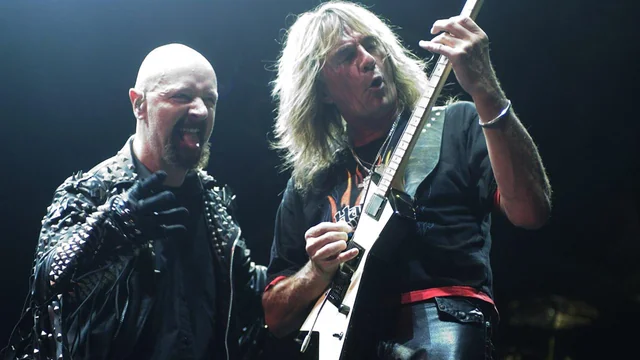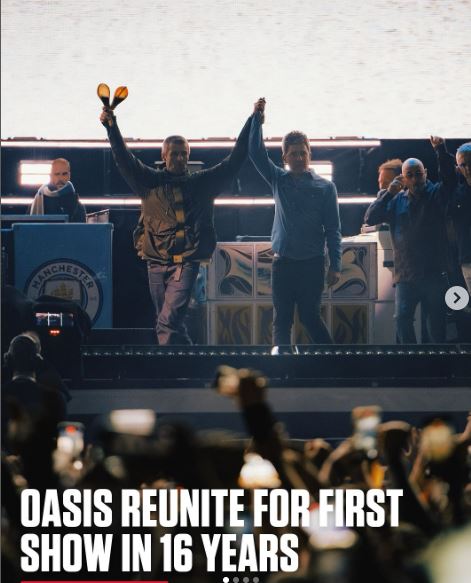How Rob Halford’s Return to Judas Priest on Judas Rising Rebuilt One of Metal’s Greatest Bands
Few comebacks in heavy metal history carry the mythic weight of Rob Halford’s triumphant return to Judas Priest. After over a decade apart, the voice that defined British steel returned, not with a whisper, but with an earth-shattering war cry on Judas Rising. And behind that resurrection was a wild, almost surreal tale—including Teletubbies, unexpected tears, and a band reborn in fire.
This is the story of how Rob Halford’s return to Judas Priest didn’t just fix a broken legacy—it reignited the very soul of metal.
🛤️ The Split That Shocked Metal
In 1992, the impossible happened: Rob Halford, the iconic frontman of Judas Priest, left the band. After two decades of leather, fire, and falsetto screams, creative tensions and a hunger to explore new sounds pulled Halford toward projects like Fight and later, Halford. Meanwhile, Priest recruited Tim “Ripper” Owens, a talented vocalist plucked from a tribute band, to fill Halford’s near-mythical boots.
Though Owens performed admirably, fans couldn’t shake the feeling: it wasn’t the same. Judas Priest without Rob Halford was like a Harley with no engine. It still looked tough, but it wasn’t roaring down the highway of metal with the same thunder.
😅 “Get Rob off the bloody Teletubbies set!”
Fast-forward to the early 2000s, and rumors began to swirl of a possible reunion. It wasn’t just wishful thinking—fans, bandmates, even the industry whispered about getting the “Metal God” back where he belonged.
And then came the strange phone call.
Rob Halford had been involved in a TV segment, of all things, that somehow got associated with the Teletubbies. It became a band joke—a surreal moment that summed up just how far they’d drifted from the molten center of metal.
“Can you get Rob off the bloody Teletubbies set, please?” someone from the Priest camp reportedly said in jest. But behind the humor was a serious yearning. The fans wanted Rob. The band needed Rob. And deep down, Rob needed Judas Priest.
🎤 Judas Rising: A Phoenix Screaming Back to Life
The true return began not on stage, but in the studio. The band quietly reconnected, and in 2005, Angel of Retribution was born. Its opening track? Judas Rising—a defiant anthem that sounded like Halford had never left. That scream. That galloping riff. That title.
It wasn’t just a song. It was a statement.
Judas Rising brought the classic lineup back with a vengeance. It roared like Painkiller and echoed the darkness of Sad Wings of Destiny, but with modern bite. Halford’s voice—older, grittier, but no less powerful—pierced through the speakers like a blade forged in hell.
Critics hailed it. Fans wept. Judas Priest was whole again.
🤘 Brotherhood Reforged
What made Halford’s return so special wasn’t just the music. It was the chemistry. When he stood beside Glenn Tipton and K.K. Downing again, you could feel the years melt away. It was as if the riffs and screams had pulled time backward, erasing the awkwardness of the split and replacing it with shared purpose.
The band openly admitted they hadn’t realized just how much they missed each other. Halford spoke of tears in the studio, of hugging old friends like soldiers reuniting after battle. It wasn’t about money or nostalgia—it was about identity.
Rob Halford was Judas Priest. And Judas Priest was Rob Halford.
🌍 A World Tour Fueled by Redemption
With Angel of Retribution in their arsenal, the band hit the road for a global tour that felt more like a coronation. Every night, fans chanted Halford’s name. Every night, Judas Rising sent shockwaves through arenas packed with believers in black.

The reunion wasn’t just a second wind—it was a full-scale storm. Halford’s iconic leather-and-chains look returned, now more self-aware and tongue-in-cheek, but still commanding. He rode motorcycles on stage. He belted out Breaking the Law like it was a battle cry. The crowds didn’t just cheer—they healed.
🎭 The Theatrics of Redemption
Rob Halford has always been more than a voice. He’s a showman, a symbol, a walking embodiment of defiance. His return brought back the dramatic tension and theatrical grandeur that Priest had been missing.
But more than that, Halford’s return represented personal redemption. Coming out as gay in the late 1990s, Halford shattered long-standing stereotypes in a genre not always known for its inclusivity. His presence became a banner for authenticity, for breaking barriers, and for embracing individuality in all its forms.
On Judas Rising, that authenticity exploded. The song didn’t shy away from their time apart. It embraced it. It screamed, “We’re back—and stronger for it.”
⚙️ Behind the Scenes: Mending Metal’s Fractures
Reunions in rock often reek of contract clauses and financial necessity. But what made Rob Halford’s return to Judas Priest feel so real was the vulnerability behind the scenes. Band members had to confront egos, regrets, and misunderstandings.
Producer Roy Z helped bridge that gap in the studio, guiding the classic lineup without diluting their fire. Halford said working on Judas Rising felt like “coming home after a long storm.” It wasn’t always easy. But it was necessary.
📣 Legacy Locked in Steel
In hindsight, Judas Rising was more than a comeback track—it was the hinge upon which Judas Priest’s legacy swung. Without Halford’s return, the band risked fading into “classic rock” nostalgia.
With it, they became immortal.
The post-2005 years saw them inducted into the Rock and Roll Hall of Fame, headline festivals alongside modern metal giants, and even experiment with operatic rock epics like Nostradamus. But nothing would have been possible without Judas Rising—the moment the phoenix screamed again.
🎶 Why Judas Rising Still Matters
Nearly two decades later, Judas Rising remains a fan favorite. Not just because it rocks (which it absolutely does), but because it’s a reminder:
- That second chances can be epic.
- That reconciliation can heal even the deepest rifts.
- That a band’s soul sometimes lives in a single voice.
Every scream, every riff, every lyric on that track carried the weight of history—and the thrill of rebirth.
🧠 Readability and Social Resonance
What makes this story resonate beyond the die-hard metalheads is its human core. Whether you’re into thrash, techno, or Taylor Swift, there’s something universally powerful about a story of return, redemption, and roar.
It’s the archetypal hero’s journey—only this hero rides a Harley and sings in six octaves.
Social media erupted when Halford rejoined. Fans who had once given up hope shared vintage photos, reunited over playlists, and introduced a new generation to the sound of British steel. It wasn’t just music. It was a movement.
🏁 Final Riff: A Comeback for the Ages
“They said, ‘Can you get Rob off the bloody Teletubbies set, please?’” might have started as a joke—but it became the turning point for a band that refused to die.
Rob Halford’s return to Judas Priest wasn’t just the best thing to happen to the band—it was one of the most powerful comebacks in rock history. Judas Rising wasn’t just a song. It was a resurrection. A scream from the ashes. A declaration that legends don’t fade—they rise.
And in doing so, Rob Halford didn’t just rebuild Judas Priest. He rebuilt belief in the power of metal itself.


